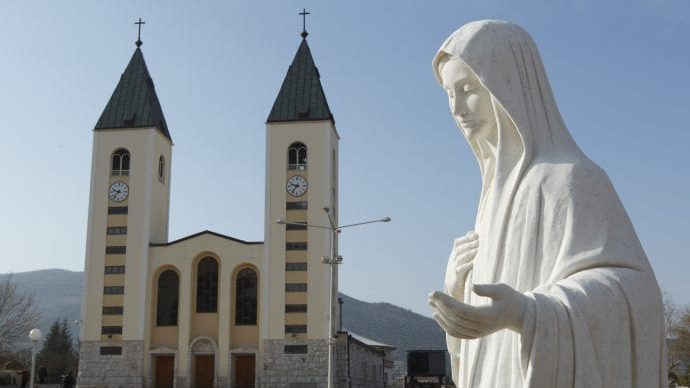Often placed in opposite sides of the spectrum by those who see the Church under the lens of politics and ideology, Pope Francis and Cardinal Robert Sarah were the protagonists of an unexpected coincidence Sunday: Both addressed 50,000 youth gathered in the site of an alleged Marian apparition.
Francis made himself present in Medjugorje through a message, signed on July 29 but which was read by the papal representative in Bosnia-Herzegovina on Sunday before Sarah, the former head of the Vatican’s liturgical office, celebrated the opening Mass for the August 1-6 youth gathering.
Medjugorje has long been a bone of contention for many Catholics, since it’s at the center of an alleged, ongoing Marian apparition, that reportedly began 1981. As a general policy, the Vatican doesn’t rule on these events while they are still going on, but this small town in Bosnia-Herzegovina has become a massive pilgrimage site.
The Argentine pontiff relatively settled the issue in May 2019, after several studies commissioned both by Francis and his immediate predecessor failed to give a conclusive affirmative or negative answer regarding origin of the phenomenon: While ordering a continuous examination of the alleged apparitions, he gave the green light for Catholics to organize pilgrimages to Medjugorje.
“The Youth Festival is an intense week of prayer and encounter with Jesus Christ, particularly in his living Word, in the Eucharist, in adoration and in the sacrament of Reconciliation,” the pope said in his message. “This event – the experience of so many tells us – has the power to set us on a path towards the Lord.”
The 32nd Mladifest youth gathering is taking place Aug. 1-6.
“Jesus sees our anguish before the emptiness of our existence left to itself, without the Good Shepherd leading us and introducing us to his holy land,” Sarah said during his homily, referencing to the Psalm of the day.
“We have come here, to Medjugorje, to renew our faith in Jesus Christ, our Redeemer, that is, to establish an authentic and vital relationship with Him, our Lord and our God, so that in prayer we can answer the crucial question: How to find Jesus and how to to behave in His penetrating and sovereign Presence?” he told the youth. “In other words, are we truly seeking God? Or more precisely, what is the place of God in our lives?”
According to the lore, the Virgin first appeared daily to six young people aged between 10 and 17 beginning June 24, 1981, but since 1989 has continued to do so only to some of them — twice a month: on the 2nd and the 25th.
Francis avoided mentioning the apparitions and focused instead on asking the young people to pray and follow Christ.
“Friends, to each of you too Jesus says: ‘Come! Follow me!’” the pope wrote in his message. “Have the courage to live your youth by entrusting yourselves to the Lord and setting out with him. Let yourselves be conquered by his loving gaze that frees us from the seduction of idols, from the false riches that promise life but bring death.”
Sarah said in his homily that those who’d met in Medjugorje had felt the need to go on pilgrimage, “which is like spiritual exercises, because we live immersed in a world that tries to live without God, while we want to meet the Lord; we have come to recharge our batteries so that we can live better in His Presence and so that we can witness to the radiance of the Truth and Mercy of God.”
When it comes to the phenomenon of apparitions, whether of Christ, his mother or some saints, the Vatican is always extremely cautious, being hesitant about issuing any official endorsements.
Perhaps nowhere in the Catholic world in recent decades has the debate over the legitimacy of an apparition been more intense than Medjugorje. Though traditionally the Vatican relies on the local bishops to determine even the slightest possibility of credibility to the phenomenon. The previous two bishops of Mostar-Duvno, the diocese to which Medjugorje belongs, have said that nothing supernatural is happening here.
Francis has voiced his suspicious of some of the more spectacular claims sometimes made by fervent Marian devotees. In November 2013, the pontiff declared that Mary “is not a postmistress, delivering messages every day,” in the context of answering a question about Medjugorje. His stance seems to have changed since then.
In a 2017 press conference, Pope Francis referred to the original apparitions at Medjugorje, which occurred when the reported visionaries were children, noting that they were studied by a commission headed by Italian Cardinal Camillo Ruini, the Vicar of Rome from 1991 to 2008, and that body was largely positive but recommended further study. As far as alleged apparitions still occurring today, he said, the report “had its doubts”. He then added that personally he’s “more negative” and that these “presumed apparitions don’t have much value.”
However, in 2018, Pope Francis appointed Henryk Hoser, retired archbishop of Warsaw-Prague, as apostolic visitor to Medjugorje. His directive, which is of an undetermined length, is to oversee the pastoral needs at the site of the alleged Marian apparitions. The bishop has voiced mild support.

